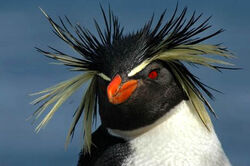Tristan da Cunha is a shield volcano, a volcanic structure with a low, broad profile and composed of silica-poor lavas (such as basalt). The upper surface of this low base appears dark green in this astronaut photograph. Steeper brown to tan colored slopes mark the central cone of the volcano at the island’s center. The summit crater, Queen Mary’s Peak, sits at an elevation of 2,060 meters (6,760 feet) above sea level. While geologic evidence indicates that eruptions have occurred from the central crater, lavas have also erupted from flank vents along the sides of the volcano and from smaller cinder cones.
The last known eruption of Tristan da Cunha took place in 1961–1962 and forced the evacuation of the only settlement on the island, Edinburgh of the Seven Seas, on the northern coastline (obscured by clouds in this image). The town is considered to be the most remote permanent settlement on Earth, with its nearest neighbor located 2,173 kilometers (1,347 miles) to the northeast on the island of St. Helena.
source
~~~~~~~~~~~~~~~~~~~~~~~~~~~~~~~~~~~~~~~~~~~~~~~~~~~~~~~~~~~~~~~~~~~~~~~~~

Northern Rockhopper Penguin
(Eudyptes Moseleyi)
Written by: Lisa Triggs, Biology 487, Winter 2009
Eudyptes moseleyi
StatusEndangered (IUCN)
The current listing of endangered is appropriate at this time. Current protection consists of marine protected areas/reserves, montoring of populations, and ecological and demographic studies.
Conservation Concerns
Past human explotation and introduced predators. Food supplies may be affected by fisheries, climate change and shifts in marine food webs. Increasing disturbance and pollution results from exotourism and fishing. Eggs taken for food and birds taken for oil. Introduced predators may affect breeding success.
Global changes are causing a decrease in primary productivity and an increase in sea surface temperatures.
There has
been a rapid population decrease over the last 30 years throughout this
penguin's range. Precise reasons for the declines are poorly known but
changes in sea surface temperature, competition and incidental capture
in fisheries and introduced predators are likely to be implicated.
Possible Actions
Continue
to monitor or start to monitor populations to assess trends. Conduct
studies to assist in interpreting population changes. Conduct studies to
assess the impacts of interactions with commercial fisheries.
Investigate the impact of introduced species at breeding colonies and
eradicate introduced species where necessary. Investigate the impact of
oil exploration and exploitation. Study the impacts of climate change.
Reduce disturbance from ecotourism. Create more marine protected areas.
Reduce/exclude large scale commercial fishing from within prescribed
distances from penguin breeding locations.
Distribution
Descriptive Characteristics
Adult
males and females are similar. They have a thin, yellow supercillium
with longer plumes and red eyes. Juveniles have a faint yellow stripe
above their eyes and the red brown bill of adults. They have a pale,
mottled gray chin. The chicks lack the yellow crest and the red-brown
bill of adults. Their bills are black. They have grey-black backs and
white fronts. There is a very small degree of sexual dimorphism between
the sexes. The females are slightly smaller with an average female to
male bill depth ratio of .85. Calls are noisy, aggressive and
demonstrative; raucous, braying sounds; more strident, pulsed squeaks,
separated by shorter periods of silence; shrill and unmusical. Four
types of calls exist - contact, sexual, agonistic and chick.
Measurements
Males Weight: 3 kg Height: 52 cm Beak Length: 4.83 cm Flipper Length: 17.40 cm Foot Length: 11.70 cm
Females
Weight: 2.50 kg Height: 52 cm Beak Length: 4.16 cm Flipper Length: 16.90 Foot Length: 10.85 cm
Breeding Biology
Average Arrival Date: July 30 Average Egg Laying Date: September 15 Incubation Period: 32 days Chick Rearing Period: 66 days Fledging Period: December 01 through December 31 Average Annual Reproductive Success: 1 chick/nest Notes: They lay 2 eggs but usually only one chick survives to fledging. Nest: Nests are located on rocky slopes and amongst tussocks; sometimes in small caves and amongst crevices. A small nest is built from tussock, peat and pebbles. Age at First Breeding: 4 years Maximum Lifespan: 30 years Average Lifespan: 10 years Egg Weight: 76.50 grams Egg Length: 6.21 cm Egg Breadth: 5.03 cm Second Egg Weight: 108.00 grams Second Egg Length: 7.15 cm Second Egg Breadth: 5.33 cm Molt: The molt is very varied depending on the location of the colony and whether there was a fialed breeding or the animal was a non-breeder. The length of the molt is approximately 23-30 days. The adult molt is pre-nuptial on the breeding sites and follows a pre-molt period at sea of 60 gays. Molt normally is in March.
Predators
Eggs and chicks are preyed upon by a variety of birds including: great skuas, brown skuas, striated caracaras, kelp gulls, dolphin gulls and turkey vultures. Adults are preyed upon by fur seals, Southern sea lions, leopard seals, blue sharks and giant petrels Juveniles are preyed upon by fur seals, Southern sea lions, leopard seals, blue sharks and giant petrels. Fledglings are preyed upon by fur seals, Southern sea lions, leopard seals, blue sharks, and giant petrels.
Prey
They
prefer Crustaceans (euphausids), small fish, and cephalopods (squid).
There is a a variability of prey resources at sea for this species and
subsequent opportunism of this penguin species to exploit what is
differentially available.
|
PDF - Rockhopper Penguins (Eudyptes Chrysocome) at Tristan da Cunha


















No comments:
Post a Comment